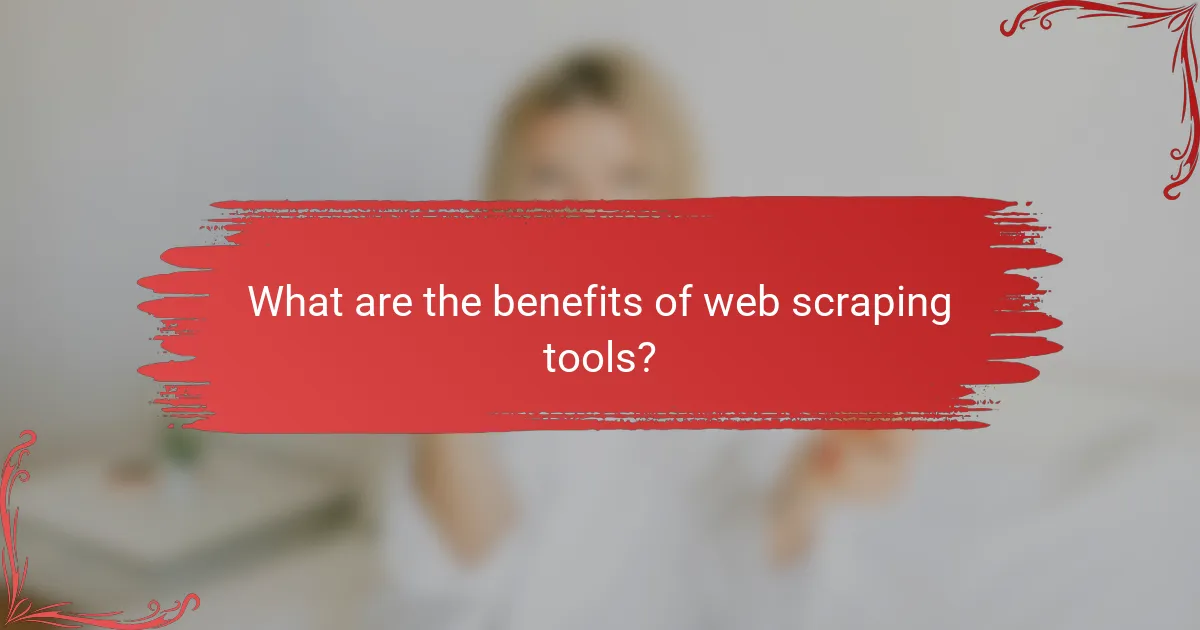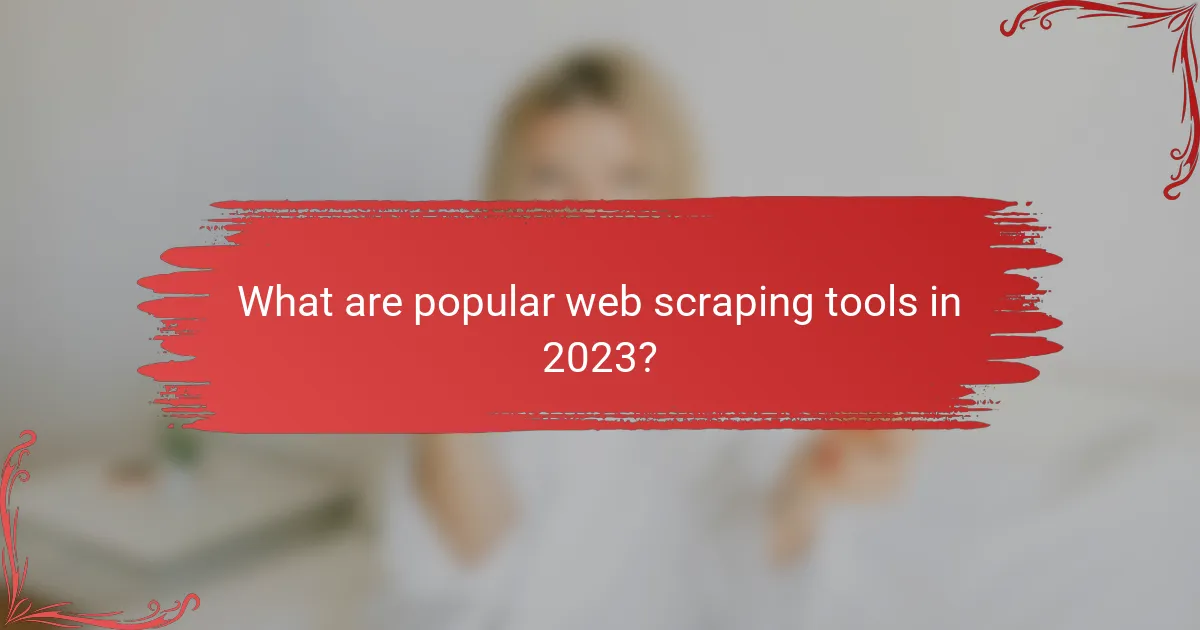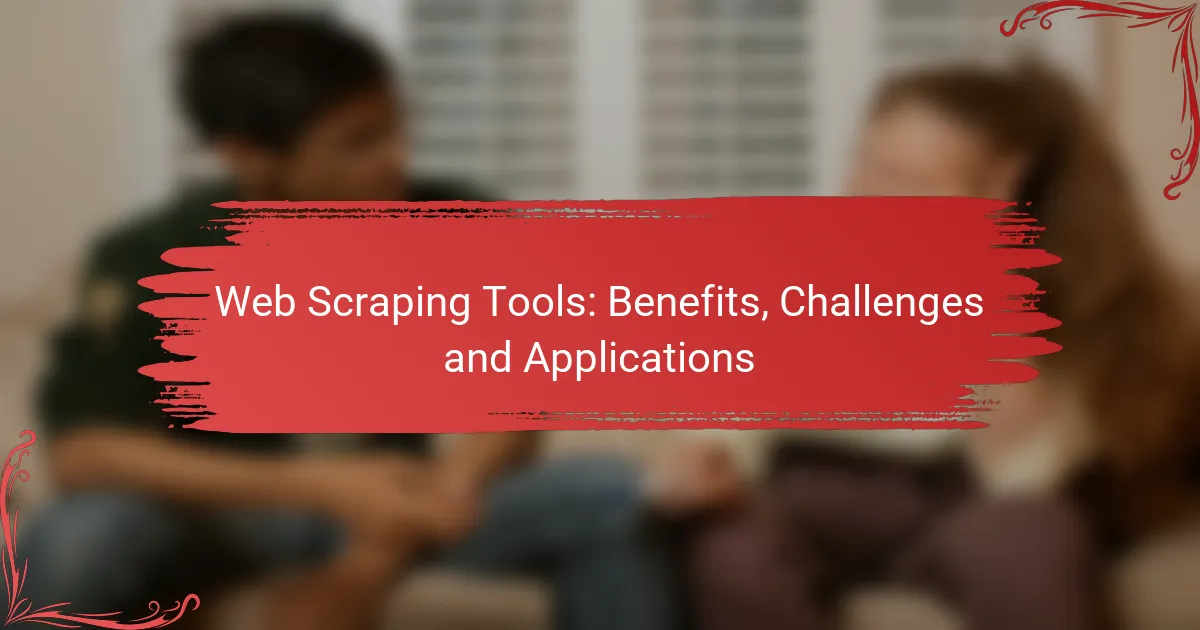Web scraping tools are essential for automating data collection, allowing users to efficiently gather large volumes of information for various applications. While they offer significant benefits, such as enhanced accuracy and speed, users must also navigate challenges like legal concerns and technical complexities to ensure effective data extraction.

What are the benefits of web scraping tools?
Web scraping tools offer significant advantages, including the ability to automate data collection, which enhances efficiency and accuracy. These tools enable users to gather large volumes of information quickly, providing valuable insights for various applications.
Data extraction efficiency
Web scraping tools streamline the process of data extraction by automating repetitive tasks. This efficiency allows businesses to collect data from multiple sources in a fraction of the time it would take manually. For instance, scraping product details from hundreds of e-commerce sites can be completed in minutes rather than hours.
Additionally, many scraping tools can handle complex websites, extracting data from dynamic content that traditional methods might miss. This capability ensures comprehensive data collection, which is crucial for informed decision-making.
Cost reduction
Implementing web scraping tools can lead to significant cost savings for businesses. By automating data collection, companies can reduce the need for extensive manpower, which translates to lower labor costs. For example, a small team can manage data scraping tasks that would typically require a larger workforce.
Moreover, many web scraping solutions are available at various price points, including free options for smaller projects. This flexibility allows businesses of all sizes to benefit from data scraping without substantial financial investment.
Market analysis capabilities
Web scraping tools enhance market analysis by providing access to vast amounts of data from competitors, industry trends, and consumer preferences. This data can be used to identify market gaps and emerging trends, enabling businesses to adapt their strategies accordingly. For instance, a retailer might scrape pricing data to adjust their own prices competitively.
Furthermore, the ability to analyze historical data over time allows companies to track changes in consumer behavior and market dynamics, leading to more informed business decisions.
Competitive intelligence
Web scraping tools are essential for gathering competitive intelligence, allowing businesses to monitor their rivals’ activities. By extracting data on competitors’ pricing, product offerings, and marketing strategies, companies can gain insights that inform their own tactics. For example, a company might track a competitor’s promotional campaigns to adjust its marketing efforts.
However, it is crucial to ensure compliance with legal and ethical standards when collecting competitive data. Familiarizing oneself with relevant regulations can help avoid potential issues.
Real-time data access
Real-time data access is one of the most significant benefits of web scraping tools. These tools can continuously monitor websites for updates, providing businesses with the latest information as it becomes available. This capability is particularly useful in fast-paced industries like finance or e-commerce, where timely data can impact decision-making.
To maximize the benefits of real-time data, businesses should implement alerts or dashboards that highlight critical changes. This proactive approach ensures that companies can respond quickly to market shifts or competitor actions.

What challenges do web scraping tools face?
Web scraping tools encounter several significant challenges that can hinder their effectiveness. These challenges include legal and ethical concerns, website blocking techniques, data quality issues, and technical complexities that require careful navigation.
Legal and ethical concerns
Legal and ethical issues are paramount when using web scraping tools. Many websites have terms of service that explicitly prohibit scraping, and violating these can lead to legal action. Additionally, ethical considerations arise regarding data ownership and privacy, particularly when personal information is involved.
To mitigate these risks, users should familiarize themselves with the legal landscape surrounding web scraping in their jurisdiction. Consulting legal experts can provide clarity on what is permissible and help avoid potential pitfalls.
Website blocking techniques
Websites often employ various blocking techniques to prevent scraping, such as IP rate limiting, CAPTCHAs, and user-agent filtering. These measures can significantly disrupt scraping efforts, making it essential for users to adapt their strategies accordingly.
To counteract these techniques, scrapers can use rotating proxies, mimic human browsing behavior, and implement delays between requests. However, these methods can increase complexity and may not always guarantee success.
Data quality issues
Data quality is a critical concern in web scraping, as the information extracted may be incomplete, outdated, or inaccurate. This can arise from changes in website structure, inconsistent data formats, or even errors in the scraping code itself.
To ensure high-quality data, scrapers should implement validation checks, regularly update their scraping scripts, and consider using multiple sources for cross-verification. This approach helps maintain data integrity and reliability.
Technical complexities
Technical complexities in web scraping can include challenges related to coding, data parsing, and maintaining scraper performance. Users often need to navigate different programming languages and libraries, which can require a steep learning curve.
To simplify these complexities, users can leverage existing frameworks and tools designed for web scraping, such as Scrapy or Beautiful Soup. Additionally, thorough documentation and community support can aid in troubleshooting and optimizing scraping processes.

How to choose the right web scraping tool?
Choosing the right web scraping tool involves evaluating your specific needs, such as the complexity of the data you want to extract, your technical skills, and your budget. Consider factors like ease of use, scalability, and the ability to handle dynamic content.
Feature comparison
When comparing web scraping tools, focus on key features such as data extraction capabilities, support for various data formats, and the ability to handle JavaScript-heavy websites. Some tools offer built-in proxies and CAPTCHA solving, which can be crucial for bypassing restrictions.
For example, tools like Scrapy and Beautiful Soup are great for developers who prefer coding, while user-friendly options like Octoparse or ParseHub cater to non-technical users. Evaluate the features that align with your project requirements to make an informed choice.
Pricing models
Web scraping tools typically offer various pricing models, including one-time purchases, monthly subscriptions, or pay-as-you-go plans. Subscription-based models often provide ongoing support and updates, while one-time purchases may require additional costs for upgrades.
For instance, tools like Apify and DataMiner offer tiered pricing based on usage, which can range from free for basic features to several hundred dollars per month for advanced capabilities. Assess your budget and expected usage to select the most cost-effective option.
User reviews
User reviews can provide valuable insights into the performance and reliability of web scraping tools. Look for feedback on ease of use, customer support, and the effectiveness of the tool in real-world applications.
Platforms like G2 and Capterra offer user-generated reviews that can help you gauge the strengths and weaknesses of different tools. Pay attention to common themes in reviews, such as ease of setup or issues with data accuracy, to guide your decision.
Integration capabilities
Integration capabilities are essential for ensuring that your web scraping tool can work seamlessly with your existing systems, such as databases, CRM software, or data analysis tools. Check if the tool supports APIs or has built-in connectors for popular platforms.
For example, tools like Import.io and Apify offer robust integration options, allowing you to automate workflows and streamline data processing. Ensure that the tool you choose can easily connect with your current technology stack to maximize efficiency.

What are popular web scraping tools in 2023?
In 2023, several web scraping tools stand out for their efficiency and versatility. These tools help users extract data from websites quickly, making them essential for various applications such as data analysis, market research, and competitive intelligence.
Scrapy
Scrapy is an open-source web crawling framework that allows users to extract data from websites efficiently. It is built in Python and is particularly suitable for large-scale web scraping projects due to its asynchronous processing capabilities, which can significantly speed up data collection.
When using Scrapy, you define “spiders” that navigate through web pages and extract specific data points. It supports various data formats, including JSON and CSV, making it easy to store and analyze the scraped information. However, users should be aware of the legal implications of scraping, as some websites may have restrictions against automated data collection.
Beautiful Soup
Beautiful Soup is a Python library that simplifies the process of parsing HTML and XML documents. It is particularly useful for beginners and smaller projects, as it allows for easy navigation and searching of the parse tree to extract the desired data.
While Beautiful Soup is not a complete web scraping framework like Scrapy, it can be combined with other libraries, such as Requests, to fetch web pages and then parse them. This combination is effective for simple scraping tasks, but users should keep in mind that it may not handle large-scale scraping as efficiently as Scrapy. Always check the website’s terms of service to ensure compliance with scraping policies.
